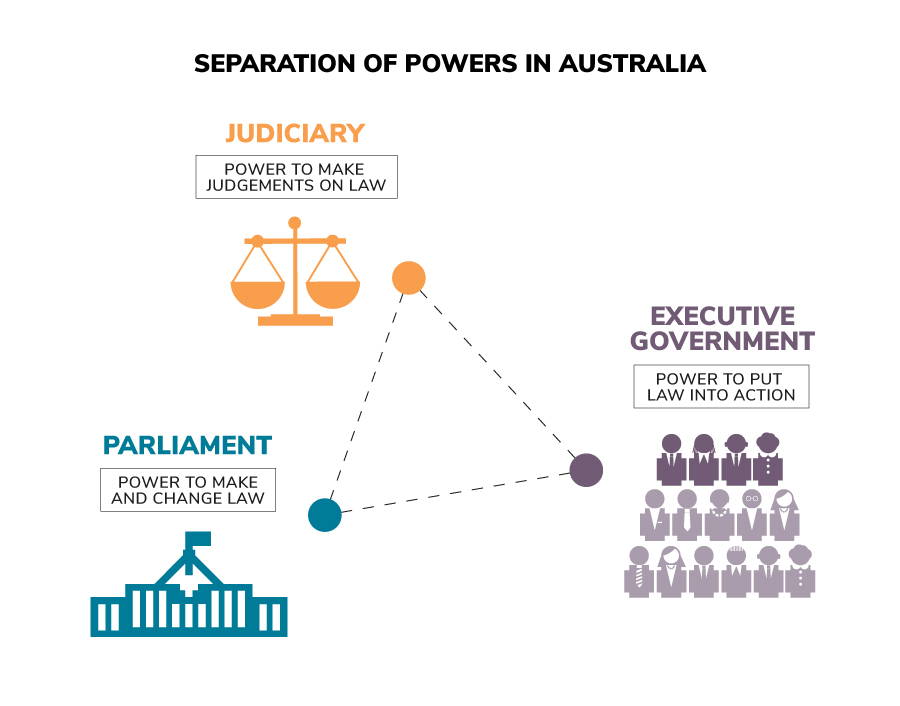Separation of powers: Parliament, Executive and Judiciary
The separation of powers distributes the power to govern between the Parliament, the Executive and the Judiciary. This fact sheet examines the powers of each group and the related principle of responsible government.
What will I learn?
- In Australia, the power to make and manage laws is shared between the Parliament, the Executive and the Judiciary.
- The separation of powers avoids any person or group having all the power.
Curriculum alignment
Year 6 ACHASSK143
Year 7 ACHCK048
Year 8 ACHCK063
Year 9 ACHCK077
What is the separation of powers?
The ‘separation of powers’ is the principle that the power to make and manage laws should be shared between different groups—the Parliament, the Executive and the Judiciary—to avoid one group having all the power.
The first 3 chapters of the Australian Constitution define the Parliament, the Executive and the Judiciary in Australia and the roles they play in making and managing laws in Australia. Each group has their own area of responsibility, and they keep a check on the actions of the others.
Separation of powers in Australia
Group |
Role |
Composition |
| Parliament | The Parliament makes and changes the law | The Australian Parliament (also referred to as the Legislature) is made up of the King (represented by the Governor-General), the Senate and the House of Representatives |
| Executive | The Executive puts the law into action | The Executive is made up of the King (represented by the Governor-General), Prime Minister and ministers |
| Judiciary | The Judiciary makes judgements about the law | The Judiciary is made up of the High Court of Australia and other federal courts |
Exceptions to the principle
Separation of powers in Australia

Parliamentary Education Office (peo.gov.au)
Description
This diagram illustrates the separation of powers in the Australian system of government. The Parliament (represented by an icon of Australian Parliament House) has the power to make and change law. The Executive (represented by a group of people) has the power to put law into action. The Judiciary (represented by an icon of a scale) has the power to make judgements on law. The three groups – Parliament, Executive and Judiciary – are connected.
Copyright information
This work is licensed under a Creative Commons Attribution-NonCommercial-NoDerivs 3.0 Unported License.
You are free to share – to copy, distribute and transmit the work.
Attribution – you must attribute the work in the manner specified by the author or licensor (but not in any way that suggests that they endorse you or your use of the work).
Non-commercial – you may not use this work for commercial purposes.
No derivative works – you may not alter, transform, or build upon this work.
Waiver – any of the above conditions can be waived if you get permission from the copyright holder.
Separation of powers in Australia

Parliamentary Education Office (peo.gov.au)
Description
This diagram illustrates the separation of powers in the Australian system of government. The Parliament (represented by an icon of Australian Parliament House) has the power to make and change law. The Executive (represented by a group of people) has the power to put law into action. The Judiciary (represented by an icon of a scale) has the power to make judgements on law. The three groups – Parliament, Executive and Judiciary – are connected.
Copyright information
This work is licensed under a Creative Commons Attribution-NonCommercial-NoDerivs 3.0 Unported License.
You are free to share – to copy, distribute and transmit the work.
Attribution – you must attribute the work in the manner specified by the author or licensor (but not in any way that suggests that they endorse you or your use of the work).
Non-commercial – you may not use this work for commercial purposes.
No derivative works – you may not alter, transform, or build upon this work.
Waiver – any of the above conditions can be waived if you get permission from the copyright holder.
Australia does not have a complete separation of powers because:
- The Prime Minister, ministers and the Governor-General are part of the Executive and the Parliament.
- High Court judges, the Prime Minister and ministers are appointed by the Governor-General, who is part of the Parliament and the Executive.
The powers of the Governor-General
Section 61 of the Constitution gives executive power to the King which is delegated – given – to the Governor-General. This means the Governor-General has power to act on behalf of the King in Australia. The power of the Governor-General is not just defined by the Constitution; it also comes from conventions – customs and traditions.
The Governor-General is part of the Executive, but the Prime Minister and ministers have day-to-day responsibility for governing Australia. The Governor-General does not have the authority to make decisions on behalf of the Prime Minister and ministers. The Governor-General normally follows their advice, and they regularly inform the Governor-General about their work.
Responsible government
The separation of powers works together with the principle of ‘responsible government’ to guide the way laws are made and managed. Responsible government means that a party or coalition of parties must have the support of the majority of members of the House of Representatives to stay in government. This provides a check on the Executive, ensuring they are accountable to Parliament and do not abuse their power.
